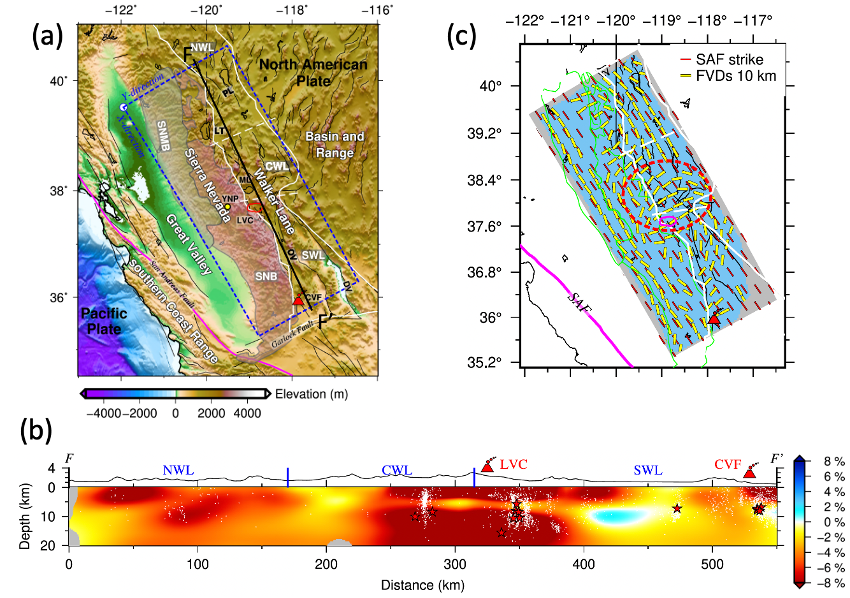2021-2022: Adjoint-state method applied to seismic tomography of Volcanic regions
See our 2022 JGR paper "Wang, K., Wu, S., & Tong, P. (2022). Crustal deformation in the Sierra Nevada and Walker Lane region inferred from P-wave azimuthal anisotropy. Journal of Geophysical Research: Solid Earth, 127, e2022JB024554. https://doi.org/10.1029/2022JB024554"

2020-2021: Full waveform joint inversion of ambient noise data and teleseismic body waves
See our 2021 JGR paper " Wang, K., Yang, Y., Jiang, C., Wang, Y., Tong, P., Liu, T., & Liu, Q. (2021). Adjoint tomography of ambient noise data and teleseismic P waves: Methodology And Applications To Central California. Journal of Geophysical Research: Solid Earth, 126, e2021JB021648. https://doi.org/10.1029/2021JB021648"

2019-2020: Teleseismic full waveform inversion
Part 1: Two way hybrid method based on SEM2D
See our 2019 GJI paper "Lin C., V. Monteiller, K. Wang*, T. Liu, P. Tong and Q. Liu, 2019. High-frequency seismic wave modeling of the deep Earth based on hybrid methods and spectral-element simulations: a conceptual study. Geophysical Journal International, doi.org/10.1093/gji/ggz413"
Part 2: Multiple plane wave hybrid method based on FK-SEM
See our 2021 BSSA paper "Wang, K., Wang, Y., Song, X., Tong, P., Liu, Q., Yang Y., 2021. Full-Waveform Inversion of High-frequency Teleseismic Body Waves based on Multiple Plane Wave Incidence: Methods and Practical Applications. Bull. Seismol. Soc. Am., 1–15, doi.org/10.1785/0120210094 "
2017-2019: Ambient noise adjoint tomography in Southern California
This project aims to obtain the 3-D anisotropic shear-wave velocity structure of southern California (Fig. 1) based on ambient noise adjoint tomography (ANAT). The inversion consists of three stages: (1) Rayleigh wave ANAT to obtain a Vsv model; (2) Love-wave ANAT to obtain a Vsh model; (3) Multi-component ANAT to obtain a radially anisotropic and azimuthal anisotropic shear-wave model.
 Map of southern California with topography, bathymetry and active faults. The solid black rectangle outlines the simulation region. The 148 stations used in this tomographic study are shown as triangles, out of which 19 are selected for line search shown in red. Faults are indicated by the bold black lines. Labels 1–8 denote the major eight geological provinces with their boundaries delineated by red dashed lines: 1. Coastal Ranges; 2. Great Central Valley; 3. Sierra Nevada; 4. Basin and Range; 5. Transverse Ranges; 6. Mojave Desert; 7. Peninsular Ranges; 8. Salton Trough. Geological features are labelledin bold white letters as references for subsequent figures: SCR, southern Coast Range; SAF, San Andreas Fault; SJV, San Joaquin Valley; SNB, Sierra Nevada Batholith; WL: Walker Lane; WBR: Western Basin and Range; WTR, CTR and ETR: western, central and eastern transverse range; ECSZ: Eastern California shear zone; LAB: Los Angeles Basin; ePRB and wPRB: east and west Peninsular Ranges Batholith; STB: Salton Trough Basin.
Map of southern California with topography, bathymetry and active faults. The solid black rectangle outlines the simulation region. The 148 stations used in this tomographic study are shown as triangles, out of which 19 are selected for line search shown in red. Faults are indicated by the bold black lines. Labels 1–8 denote the major eight geological provinces with their boundaries delineated by red dashed lines: 1. Coastal Ranges; 2. Great Central Valley; 3. Sierra Nevada; 4. Basin and Range; 5. Transverse Ranges; 6. Mojave Desert; 7. Peninsular Ranges; 8. Salton Trough. Geological features are labelledin bold white letters as references for subsequent figures: SCR, southern Coast Range; SAF, San Andreas Fault; SJV, San Joaquin Valley; SNB, Sierra Nevada Batholith; WL: Walker Lane; WBR: Western Basin and Range; WTR, CTR and ETR: western, central and eastern transverse range; ECSZ: Eastern California shear zone; LAB: Los Angeles Basin; ePRB and wPRB: east and west Peninsular Ranges Batholith; STB: Salton Trough Basin.
Part 1-Rayleigh wave ANAT in southern California
See our GJI paper "Refined crustal and uppermost structure of southern California by ambient noise adjoint tomography".
Part 2-3D Sensitivity kernels for multi-component ambient noise empirical Green's function with application to Love wave ANAT in southern California
See our JGR paper "Three-Dimentional Sensitivity Kernels for Multi‐component Empirical Green's Functions from Ambient Noise: Methodology and Application to Adjoint Tomography"
Part 3-Crustal raidal anisotropy of southern California revealed from multi-component ANAT
See our GRL paper "Wang K.*, C. Jiang*, Y. Yang, V. Schulte-Pelkum, Q. Liu, 2019. Crustal deformation in southern California constrained by radial anisotropy from ambient noise adjoint tomography. Geophysical Research Letters, https://doi.org/10.1029/2020GL088580"
